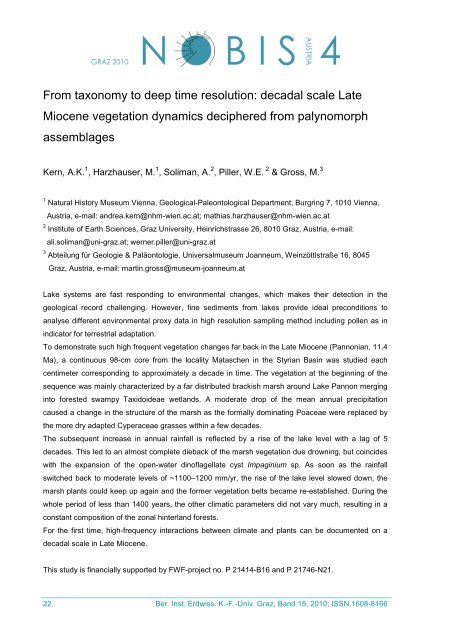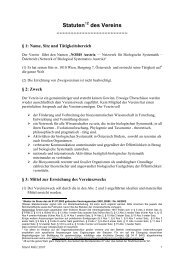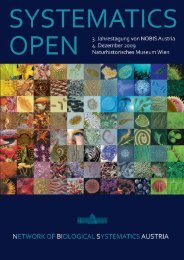4. Jahrestagung von NOBIS Austria 2. - 3. Dezember 2010
4. Jahrestagung von NOBIS Austria 2. - 3. Dezember 2010
4. Jahrestagung von NOBIS Austria 2. - 3. Dezember 2010
You also want an ePaper? Increase the reach of your titles
YUMPU automatically turns print PDFs into web optimized ePapers that Google loves.
From taxonomy to deep time resolution: decadal scale Late<br />
Miocene vegetation dynamics deciphered from palynomorph<br />
assemblages<br />
Kern, A.K. 1 , Harzhauser, M. 1 , Soliman, A. 2 , Piller, W.E. 2 & Gross, M. 3<br />
1 Natural History Museum Vienna, Geological-Paleontological Department, Burgring 7, 1010 Vienna,<br />
<strong>Austria</strong>, e-mail: andrea.kern@nhm-wien.ac.at; mathias.harzhauser@nhm-wien.ac.at<br />
2 Institute of Earth Sciences, Graz University, Heinrichstrasse 26, 8010 Graz, <strong>Austria</strong>, e-mail:<br />
ali.soliman@uni-graz.at; werner.piller@uni-graz.at<br />
3 Abteilung für Geologie & Paläontologie, Universalmuseum Joanneum, Weinzöttlstraße 16, 8045<br />
Graz, <strong>Austria</strong>, e-mail: martin.gross@museum-joanneum.at<br />
Lake systems are fast responding to environmental changes, which makes their detection in the<br />
geological record challenging. However, fine sediments from lakes provide ideal preconditions to<br />
analyse different environmental proxy data in high resolution sampling method including pollen as in<br />
indicator for terrestrial adaptation.<br />
To demonstrate such high frequent vegetation changes far back in the Late Miocene (Pannonian, 11.4<br />
Ma), a continuous 98-cm core from the locality Mataschen in the Styrian Basin was studied each<br />
centimeter corresponding to approximately a decade in time. The vegetation at the beginning of the<br />
sequence was mainly characterized by a far distributed brackish marsh around Lake Pannon merging<br />
into forested swampy Taxidoideae wetlands. A moderate drop of the mean annual precipitation<br />
caused a change in the structure of the marsh as the formally dominating Poaceae were replaced by<br />
the more dry adapted Cyperaceae grasses within a few decades.<br />
The subsequent increase in annual rainfall is reflected by a rise of the lake level with a lag of 5<br />
decades. This led to an almost complete dieback of the marsh vegetation due drowning, but coincides<br />
with the expansion of the open-water dinoflagellate cyst Impaginium sp. As soon as the rainfall<br />
switched back to moderate levels of ~1100–1200 mm/yr, the rise of the lake level slowed down, the<br />
marsh plants could keep up again and the former vegetation belts became re-established. During the<br />
whole period of less than 1400 years, the other climatic parameters did not vary much, resulting in a<br />
constant composition of the zonal hinterland forests.<br />
For the first time, high-frequency interactions between climate and plants can be documented on a<br />
decadal scale in Late Miocene.<br />
This study is financially supported by FWF-project no. P 21414-B16 and P 21746-N21.<br />
_____________________________________________________________________________<br />
22 Ber. Inst. Erdwiss. K.-F.-Univ. Graz, Band 15, <strong>2010</strong>; ISSN 1608-8166






